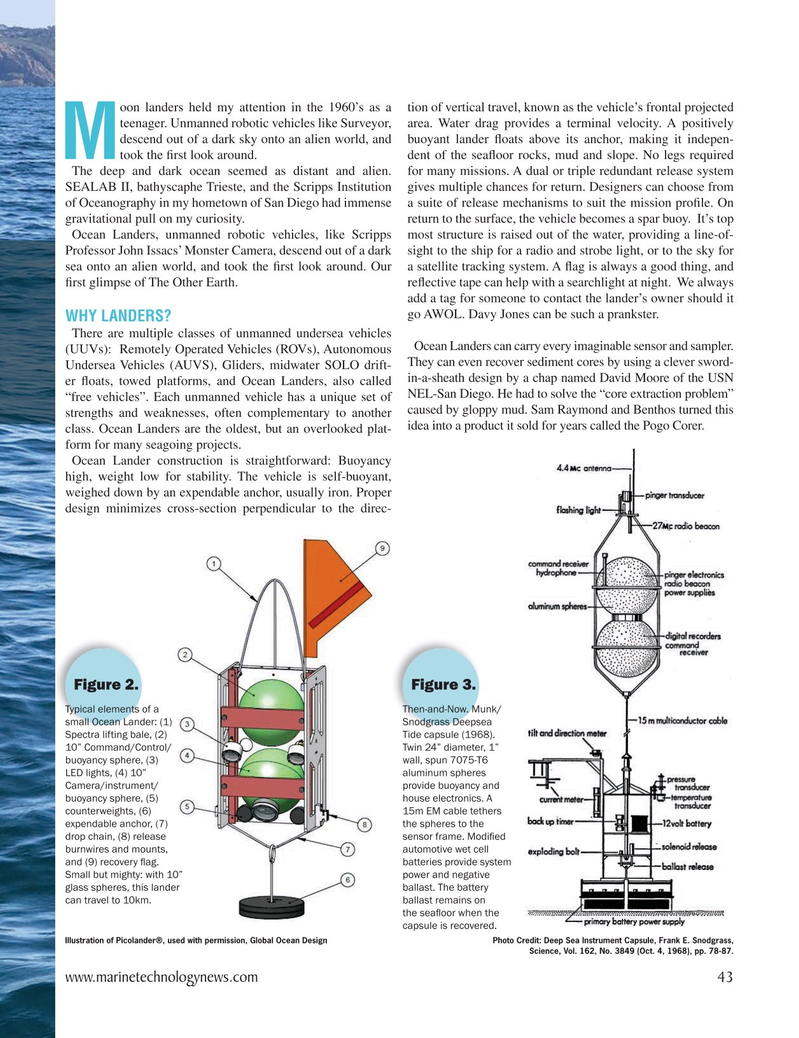
Page 43: of Marine Technology Magazine (January 2022)
Read this page in Pdf, Flash or Html5 edition of January 2022 Marine Technology Magazine
oon landers held my attention in the 1960’s as a tion of vertical travel, known as the vehicle’s frontal projected teenager. Unmanned robotic vehicles like Surveyor, area. Water drag provides a terminal velocity. A positively descend out of a dark sky onto an alien world, and buoyant lander ? oats above its anchor, making it indepen-
Mtook the ? rst look around. dent of the sea? oor rocks, mud and slope. No legs required
The deep and dark ocean seemed as distant and alien. for many missions. A dual or triple redundant release system
SEALAB II, bathyscaphe Trieste, and the Scripps Institution gives multiple chances for return. Designers can choose from of Oceanography in my hometown of San Diego had immense a suite of release mechanisms to suit the mission pro? le. On gravitational pull on my curiosity. return to the surface, the vehicle becomes a spar buoy. It’s top
Ocean Landers, unmanned robotic vehicles, like Scripps most structure is raised out of the water, providing a line-of-
Professor John Issacs’ Monster Camera, descend out of a dark sight to the ship for a radio and strobe light, or to the sky for sea onto an alien world, and took the ? rst look around. Our a satellite tracking system. A ? ag is always a good thing, and ? rst glimpse of The Other Earth. re? ective tape can help with a searchlight at night. We always add a tag for someone to contact the lander’s owner should it go AWOL. Davy Jones can be such a prankster.
WHY LANDERS?
There are multiple classes of unmanned undersea vehicles
Ocean Landers can carry every imaginable sensor and sampler. (UUVs): Remotely Operated Vehicles (ROVs), Autonomous
They can even recover sediment cores by using a clever sword-
Undersea Vehicles (AUVS), Gliders, midwater SOLO drift- er ? oats, towed platforms, and Ocean Landers, also called in-a-sheath design by a chap named David Moore of the USN “free vehicles”. Each unmanned vehicle has a unique set of NEL-San Diego. He had to solve the “core extraction problem” strengths and weaknesses, often complementary to another caused by gloppy mud. Sam Raymond and Benthos turned this idea into a product it sold for years called the Pogo Corer.
class. Ocean Landers are the oldest, but an overlooked plat- form for many seagoing projects.
Ocean Lander construction is straightforward: Buoyancy high, weight low for stability. The vehicle is self-buoyant, weighed down by an expendable anchor, usually iron. Proper design minimizes cross-section perpendicular to the direc-
Figure 2. Figure 3.
Typical elements of a Then-and-Now. Munk/ small Ocean Lander: (1) Snodgrass Deepsea
Spectra lifting bale, (2) Tide capsule (1968). 10” Command/Control/ Twin 24” diameter, 1” buoyancy sphere, (3) wall, spun 7075-T6
LED lights, (4) 10” aluminum spheres
Camera/instrument/ provide buoyancy and buoyancy sphere, (5) house electronics. A counterweights, (6) 15m EM cable tethers expendable anchor, (7) the spheres to the drop chain, (8) release sensor frame. Modi? ed burnwires and mounts, automotive wet cell and (9) recovery ? ag. batteries provide system
Small but mighty: with 10” power and negative glass spheres, this lander ballast. The battery can travel to 10km. ballast remains on the sea? oor when the capsule is recovered.
Illustration of Picolander®, used with permission, Global Ocean Design Photo Credit: Deep Sea Instrument Capsule, Frank E. Snodgrass,
Science, Vol. 162, No. 3849 (Oct. 4, 1968), pp. 78-87.
www.marinetechnologynews.com 43
MTR #1 (34-49).indd 43 1/25/2022 9:15:24 AM

 42
42

 44
44
